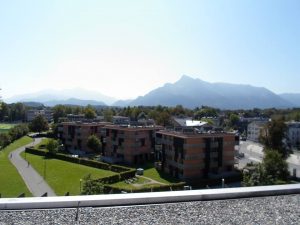Monday, 7.40 AM. Fog pours into the streets and the square starts to fill up as another workday has just begun. People are accumulating on the platform, ready to fight. Yes, fight. Some of them are quietly staring at their smartphones, but expectation is hanging in the air. Then there’s a light chime. With its awaited, growing rustle, the tram appears at the beginning of the platform. The heads turn and follow automatically that cable-driven truck, everybody hoping to be the lucky guy who finds themselves in front of the sliding door. The tram stops. Time stops. The doors open and the melee pushes inside, grumbling and trying to reach the most longed goal at that moment: a free seat. After less than a minute of catch-as-catch-can each passenger has found their place in this little ecosystem on rails.
Equilibrium principles
More than any other ecosystem, the tram needs to maintain a certain equilibrium during its urban rollercoaster ride. The public transport in Augsburg (aka AVV Racing Team) provides a unique service of balance training, thanks to sudden accelerations and abrupt braking, no matter if you’re sitting or standing. Grasping on to any possible object in the tram is the basic rule of such peculiar environment; it could be a pole, a strap or…another passenger. The latest extreme example of savage desperation to find the right equilibrium was a short woman who leant against another one’s breasts during the whole ride to Kö. No, the two women didn’t even know each other.
Fighting without referee
As we’ve already seen, the tram is a very “physical” space. A place where all kinds of dangerous studs-up tackles and nudges will never be subject to a yellow or red card. But not only body parts are involved. The most life-threatening weapon in this case is the backpack. These self-propelled bags are kind of their own life form, with the owner apparently not knowing the real bulk of what they’re carrying. Thousands of victims suffer on a daily basis: innocent noses, shoulders and backs which can’t even seek justice as what happens on the tram, stays on the tram!
 Riding into freedom
Riding into freedom
In some ways this is the secret beauty of the tram: anyone is free to do what they want during the ride. You can listen to a wide variety of languages spoken by passengers, whether they are tourists or foreign inhabitants, or you can turn on you MP3-player and pretend to be in a music video. You can chat with interesting urban philosophers or chat on your smartphone, keeping an eye on your neighbor who is probably craning his neck to snoop your messages. You can look out of the window or steal a glance at other passengers… Oh no. That old man’s wearing tight shorts…Without underpants… I must get off. “Ding dong. Next stop: Cathedral”. Thank God!
Author & Pictures: Veronica Armellini



 The chatterer
The chatterer
 a-like contest
a-like contest




 But the reason why using up so much adrenaline was worthwhile was meeting so many amazing creatures. These guys impressed me quite a lot: giant otters. Seeing a pair of them right in front of me was a dream come true; I didn’t know if I should take a picture or step back a bit and be sure I was safe. Giant river otters are extremely cute and are innocent-looking, but they’re very dangerous and are capable of attacking and even eating a caiman! Take a look yourself and see how photogenic they are – one of them even looked into the camera! How adorable is that?
But the reason why using up so much adrenaline was worthwhile was meeting so many amazing creatures. These guys impressed me quite a lot: giant otters. Seeing a pair of them right in front of me was a dream come true; I didn’t know if I should take a picture or step back a bit and be sure I was safe. Giant river otters are extremely cute and are innocent-looking, but they’re very dangerous and are capable of attacking and even eating a caiman! Take a look yourself and see how photogenic they are – one of them even looked into the camera! How adorable is that?
 We also saw anacondas, blue macaws, toucans, southern crested carcaras, capybaras and lizards. The only animal we didn’t bump into was the gorgeous jaguar. Maybe we’ll be luckier next time, on another road trip around Brazil. Until then, let’s keep an eye on the natural world around us and enjoy it as best we can!
We also saw anacondas, blue macaws, toucans, southern crested carcaras, capybaras and lizards. The only animal we didn’t bump into was the gorgeous jaguar. Maybe we’ll be luckier next time, on another road trip around Brazil. Until then, let’s keep an eye on the natural world around us and enjoy it as best we can!



 The origin
The origin